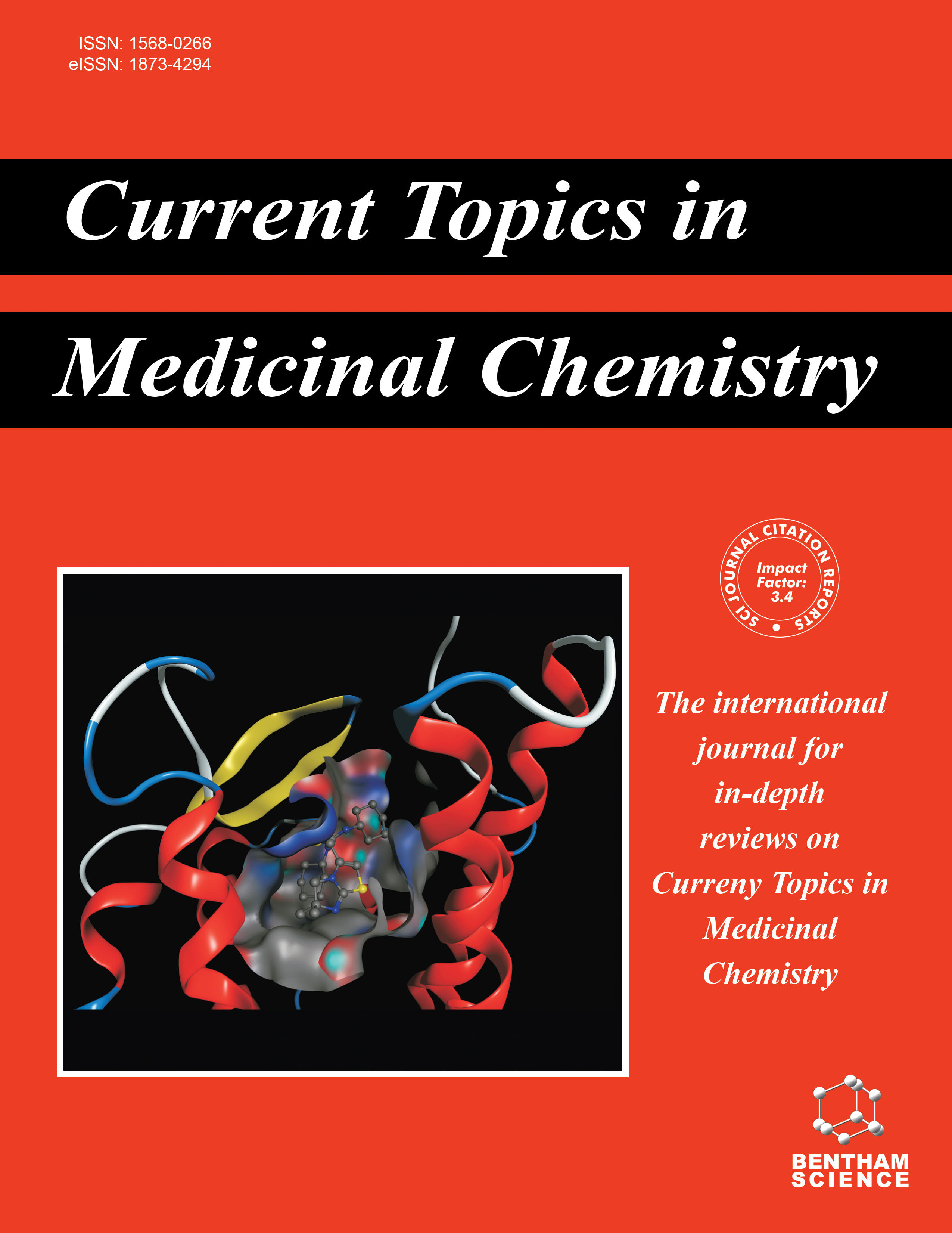- Home
- A-Z Publications
- Current Topics in Medicinal Chemistry
- Previous Issues
- Volume 23, Issue 12, 2023
Current Topics in Medicinal Chemistry - Volume 23, Issue 12, 2023
Volume 23, Issue 12, 2023
-
-
Application and SARs of Pyrazolo[1,5-a]pyrimidine as Antitumor Agents Scaffold
More LessAuthors: Yadong Zhang, Di Wen, Jiwei Shen, Lu Tian, Yan Zhu, Jifang Zhang, Leyan Zhao, Shi Ding, Ju Liu and Ye ChenPyrazolo[1,5-a]pyrimidines are fused heterocycles that have spawned many biologically active antitumor drugs and are important privileged structures for drug development. Pyrazolo[1,5- a]pyrimidine derivatives have played an important role in the development of antitumor agents due to their structural diversity and good kinase inhibitory activity. In addition to their applications in traditional drug targets such as B-Raf, K Read More
-
-
-
Probing into the Flap-dimer Dynamics of the Mycobacterium tuberculosis Kasa Enzyme Binding Landscape Provides the Underlying Inhibitory Mechanisms of JSF-3285 and 5G
More LessBackground: β-ketoacyl-ACP synthase I (KasA I) enzyme is crucial in mycolic acid synthesis via catalytic condensation reactions, hence implicated in M. tuberculosis’s virulence and drug resistance. Presently, there is no known potent KasA inhibitor; thiolactomycin lacks potency. Recently reported indazole compounds JSF-3285/tr1DG167 and 5G/tr2DG167 inhibit the KasA through binding to the substrate cavity. However, the molecul Read More
-
-
-
2,3-Diarylindoles as COX-2 Inhibitors: Exploring the Structure-activity Relationship through Molecular Docking Simulations
More LessAuthors: Andrea Cuppoloni, João Vitor Silva, Timothy J. Snape, Samridhi Lal and Jeanine GiarollaBackground: Arylindole derivatives are promising scaffolds in the design of new drugs. These scaffolds exhibit a wide biological activity, including inhibition of COX-2, antitumor activity, receptor GABA agonism, and estrogen receptor modulation. Objectives: Taking this into account, this paper presents a study to understand the inhibitory action of certain 2-arylindole derivatives, specifically a series of 2,3-diarylindoles with IC50 Read More
-
-
-
Aberrant Lipid Metabolism in Cancer: Current Status and Emerging Therapeutic Perspectives
More LessAuthors: Rasha Irshad, Sazi Tabassum and Mohammad HusainIt is now an undisputed fact that cancer cells undergo metabolic reprogramming to support their malignant phenotype, and it is one of the crucial hallmarks which enables cancer cells to facilitate their survival under variable conditions ranging from lack of nutrients to conditions, such as hypoxia. Recent developments in technologies, such as lipidomics and machine learning, have underlined the critical effects of altered li Read More
-
-
-
Tumor-associated Macrophages (TAMs) in Cancer Resistance; Modulation by Natural Products
More LessTumor-associated macrophages (TAMs) play a pivotal role in the progression and resistance of tumors to different anticancer drugs. TAMs can modulate the tumor microenvironment (TME) in favor of immune system exhaustion. The interactions of TAMs with TME can affect the function of cytotoxic CD8+ T lymphocytes (CTLs) and natural killer (NK) cells. Furthermore, TAMs can induce cancer cell proliferation by releasing s Read More
-
-
-
The Role of Phytochemicals in Cancer Prevention: A Review with Emphasis on Baicalein, Fisetin, and Biochanin A
More LessAuthors: Juhi Rais, Habiba Khan and Mohd. ArshadCancer is a disease in which repeated rounds of mutations cause uncontrolled growth of cells, which prospers at the expense of their neighbor cells and then eventually leads to the destruction of the whole cellular community. Chemopreventive drugs either prevent DNA damage, which results in malignancy, or they stop or reverse the division of premalignant cells with DNA damage, which inhibits the growth of cancer. There is an Read More
-
-
-
Insight into Tumor Hypoxia: Radionuclide-based Biomarker as Diagnostic Tools
More LessAuthors: Priya Saxena, Sanjay Gambhir and Manish DixitThe radiolabeled tracers have been extensively utilized to access various physiological and pathological conditions non-invasively, such as cancers, inflammation, and organ-specific imaging. These tracers demonstrate and study tumor hypoxia in several malignancies. Hypoxia is commonly seen in solid tumors. Tumor Hypoxia is a non-physiological condition of reduced oxygen concentration in the tumor. Hypoxia is associated with Read More
-
Volumes & issues
-
Volume 25 (2025)
-
Volume 24 (2024)
-
Volume 23 (2023)
-
Volume 22 (2022)
-
Volume 21 (2021)
-
Volume 20 (2020)
-
Volume 19 (2019)
-
Volume 18 (2018)
-
Volume 17 (2017)
-
Volume 16 (2016)
-
Volume 15 (2015)
-
Volume 14 (2014)
-
Volume 13 (2013)
-
Volume 12 (2012)
-
Volume 11 (2011)
-
Volume 10 (2010)
-
Volume 9 (2009)
-
Volume 8 (2008)
-
Volume 7 (2007)
-
Volume 6 (2006)
-
Volume 5 (2005)
-
Volume 4 (2004)
-
Volume 3 (2003)
-
Volume 2 (2002)
-
Volume 1 (2001)
Most Read This Month
Article
content/journals/ctmc
Journal
10
5
false
en


